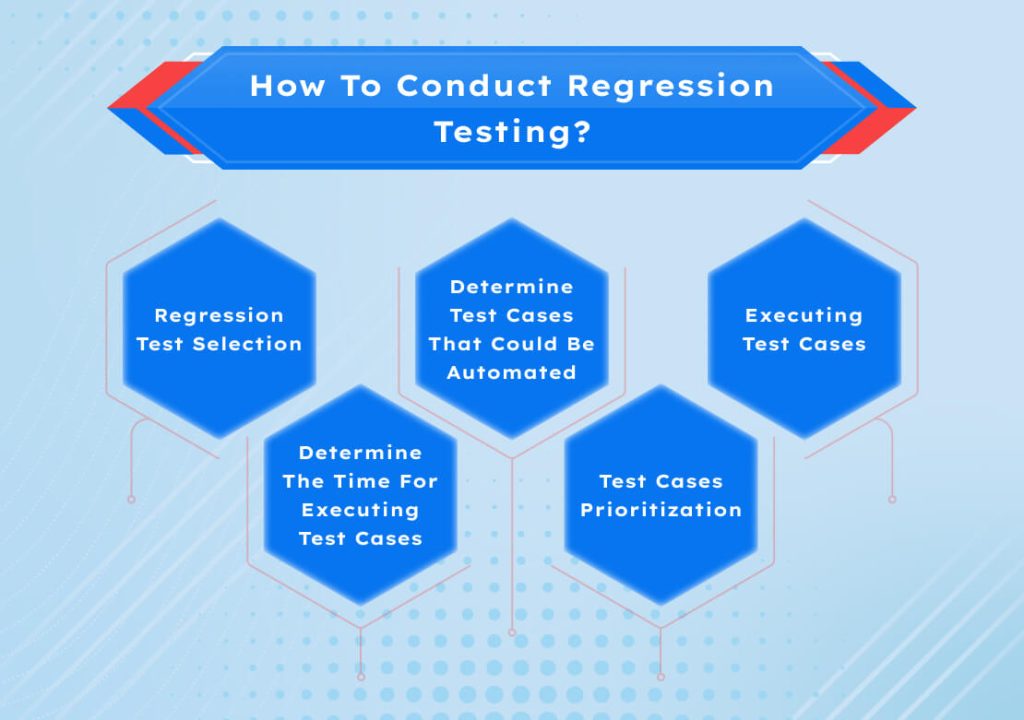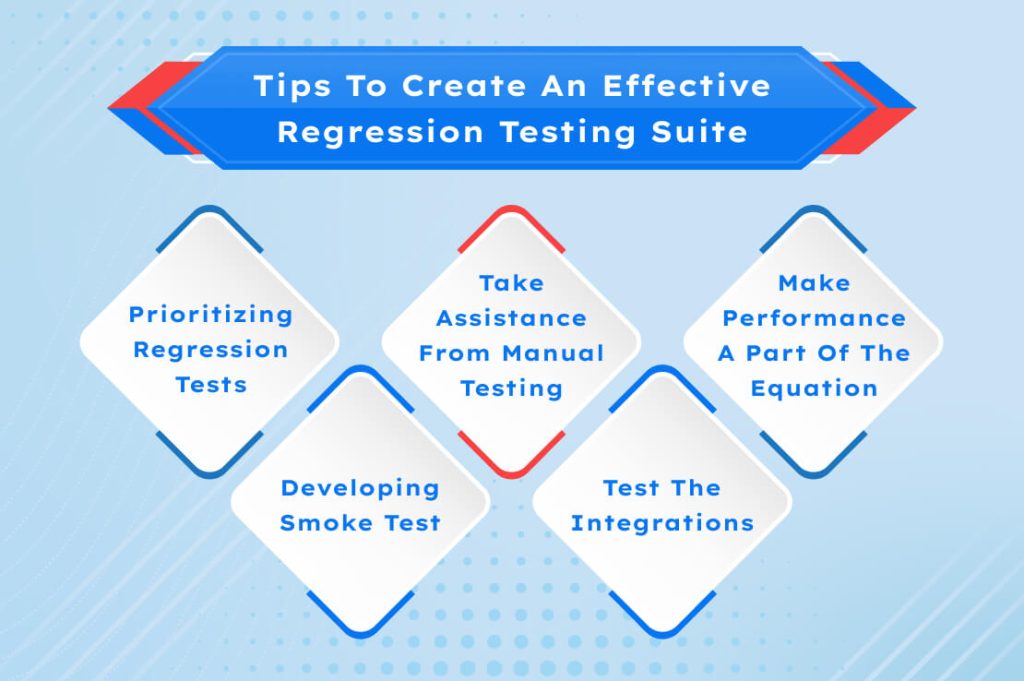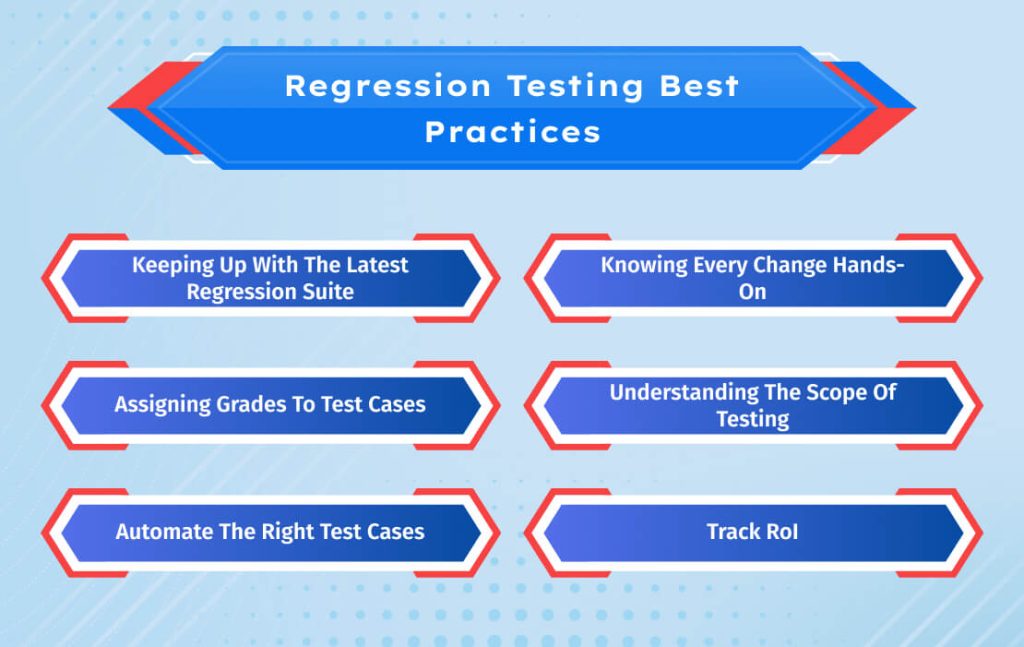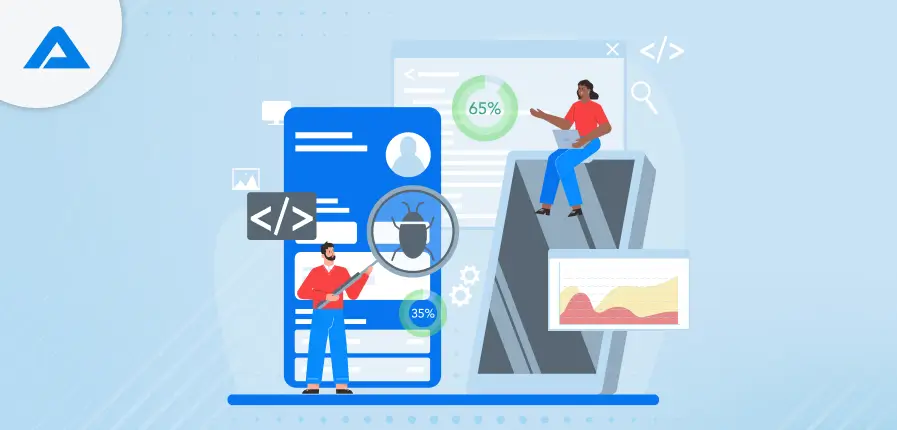Introducing changes in a vast cohering code base can take time and effort. Introducing a new feature correction, bug fix, or upgrade could alter what is currently working in the version of an application or application on the web or website. Have you ever wondered how your favourite software and apps remain amazing even with many upgrades? Think about it this way: developers have been coding in a blaze of energy while hiring QA Engineers to don their hats as new features are constantly introduced. With significant change comes much responsibility, ensuring that everything works as intended and that no bugs have made their way into the system! Regression testing is the place to jump into action to help!
Regression testing is an essential test procedure involving regular testing of existing functions of any software, program, or system when it gets new enhancements. Testers conduct testing to verify that the software’s functioning, both new and live, is functional and unaffected. In this testing method, the quality analyst examines the functional and non-functional components of the current features to ensure no new bugs or mistakes are discovered in the program.
In this blog post, we’ll provide an extensive description of regression testing, including test scenarios, methods, and types, as well as all the vital information you should learn. Let’s delve right into it!
What Is Regression Testing?
Regression testing is one type of testing software conducted following an update to verify that the change did not introduce new problems. This is because new codes might introduce an entirely new system of logic, which could conflict with the code already in place, leading to problems. Most of the time, QA teams have several tests that are regression-based on essential components, which they repeat each time code modifications occur to reduce time and increase the effectiveness of tests.
If a project doesn’t use a system for managing version changes, it is difficult to identify the specific element that causes the issue. But when we test for regression, it is clear where the problem originates, which can help us troubleshoot it better. Regression testing is a regular examination of software’s health status. Because of its frequent nature, regression testing can be an ideal candidate for automated testing.
Why The Regression Test?
Regression occurs when a developer fixes an issue or introduces a new program to add new functions to the software. The new or existing features could depend on a variety of other factors. This is a way to determine if the newly added software is compatible with the previous code to ensure that the original code does not suffer. Most often, the testers are responsible for evaluating any last-minute modifications to the software.
If this is the case, the test only affects areas of the application and must be finished within the timeframe required by testing all of the system’s main components. This test becomes important in the event of constant modification or improvement to the system. This new feature should not adversely affect the tested software.
Regression is necessary to discover bugs that have occurred due to software alteration. If the testing process isn’t performed, the software could have critical issues in the actual environment, leading customers to a snag. In testing an online site, the tester will report a problem with the product’s price not being correctly displayed, i.e., it shows a lower price than the price, which must be addressed quickly.
After the developer has fixed the problem, it must be rechecked in conjunction with regression testing, which is also required to confirm the price. The reported page has been fixed. However, there could be an error in the summary section where the amount is listed alongside other costs, or the email addressed to the customer needs to show the right price. Customers will need to pay the price if this test isn’t done, as the site estimates the total cost with an incorrect price. The identical price is sent to the client via email. If the buyer agrees, the product is offered cheaper online. This is an expense for the buyer.
This testing has significant roles and is essential.

Want to automate your regression testing processes with leading tools and technologies?

Pooja Upadhyay
Director Of People Operations & Client Relations
Regression Testing Example In Practice
For instance, a company developing software releases the latest software for video editing. The main requirement is to make their first release using only core functions. Before releasing the product, the regression test uses 1,000 test cases to verify that you have the most basic editing or freemium capabilities. Once it’s passed the test with flying colours, the first build you create can be released to the market.
But, after the success of the first app making waves in the editing industry, your business team returns and demands the addition of several new premium features. The team develops them and then adds them to your current application. However, a regression test becomes necessary due to introducing new code and features. So, you have to write 100 new test scenarios to confirm the operation of these newly added features. But you’ll need to test those old 1000 tests you have already run to ensure that vital functions aren’t broken.
This regression testing method may seem tedious, but it is reliable for discovering never-occurring issues.
When To Perform Regression Testing?
Regression testing is recommended to be carried out every time changes are made to a software system or the program is changed, such as making new features available bugs, fixes for bugs, or improving performance. Regression testing is appropriate in situations that include:
- An additional feature or function can be added to the app
- You may have developed a website with an option for users to log in only through email. Then, you have added access via Facebook.
- The requirement has changed.
- If codebase bugs are discovered or patches are addressed, they can be fixed.
- If someone reports an issue with the login button, developers resolve the problem. The login button is examined for the expected outcomes; however, tests are also conducted for additional functions related to that login button.
- If performance issues can be fixed.
- In the event of environment or configuration modifications.
In other words, you can update your database to change the database from MySQL to switch it over to Oracle.
Regression Testing Techniques
Many regression tests can be employed based on the software’s characteristics and implemented modifications. Below are a few commonly utilized tests for regression,
Regression Test Selection
This method allows us to pick specific test cases out of the test suite to test the component that needs to be tested once more regarding the changes made to the code. Test cases are classified as being reusable or obsolete. Reusable test cases can be utilized in the future regression cycle, while outdated test cases cannot be utilized in future regression cycles.
Test Case Prioritization
Instead of testing each test, this method prioritizes and identifies the most crucial test cases.
Re-Test All
The method involves testing all of the existing tests.
Hybrid
This mix combines Regression Test Selection and Test Methods of Case Prioritization. Instead of selecting the whole test set, we choose those test cases that have been re-examined according to their importance.
Corrective Regression Testing
This helps ensure the current software works correctly and checks whether the current test cases can be used. If the test results are positive, QAs are confident that the test scenarios have been tested and are up-to-date. Also, it allows QA to continue by establishing priorities for testing and planning as they incorporate new changes to code into the testing procedure.
Progressive Regression Testing
This is an approach to testing in which QAs realize that any code changes could require modifications to test suites. Therefore, they make changes to the test scripts to align with the requirements of the latest version. This approach is employed when an alteration affects the idea.
Selective Regression Testing
Selective regression testing aims to determine how the program responds to new code included in the software. In this case, a small portion of cases to test is chosen according to the altered parts of the program.
Partial Regression Testing
Partially regression testing can help uncover issues that might occur when new code integrates with existing code. It ensures that the new code does not affect the app’s performance.
How To Conduct Regression Testing?

There is generally an unwritten rule for implementing regression testing. However, a QA analyst must remember a few standard regression testing techniques.
Regression Test Selection
As the title suggests, it is a test where you choose the scenarios that require re-testing. The test suite isn’t tested in the whole test set, and the choice of the test cases you decide to use will be based on the module in which changes have been made to its source code. Ultimately, you will divide the tests by (i) Usable and (ii) Old Test Cases. Reusable ones can be used in future regression cycles, but you shouldn’t consider Obsolete cases for upcoming tests.
Determine The Time For Executing Test Cases
The following step is to calculate the time it would require to run the tests. Some factors that influence the test duration are data generation and regression test plan-making for a QA team, regression test planning by the QA team, and review of each test case.
Determine Test Cases That Could Be Automated
Based on their findings from exploratory tests, the QA team will decide which testing cases to automate during this step. Automated tests run faster than manual testing, allowing users to reuse the same test case repeatedly. Thus, the test cases were split into two sections: (i) manual tests and (ii) automated tests.
Test Cases Prioritization
This is where you will gather all test scenarios, prioritizing them according to their priority, i.e., medium, high, moderate, and low. Based on this assessment, you’ll run the tests with the highest priority first, then medium and low tests with a low priority. Its functionality and user involvement will determine the priority of each test.
Executing Test Cases
Then, you can complete all the test cases in sequence and determine whether the software functions according to plan. Based on the requirements, you can use automated testing or manual testing. Automated regression testing uses functional testing tools such as Selenium, QTP, Watir, and others. This allows you to complete the test scenarios quickly.
Tips To Create An Effective Regression Testing Suite

A regression testing suite collects test scenarios to ensure your program functions as expected after an update or change. The following are the methods for creating an efficient software regression testing suite.
Prioritizing Regression Tests
It is crucial to create a successful regression testing solution. It is helpful to give test cases that test the most important functions the top priority. These could relate to the backend engine, API, database, etc. The remaining part of the application must be given second priority. The third priority should be given to the last priority, evaluating situations related to technical debt.
Developing Smoke Test
High-priority tests are assigned a smoking test label. You are required to test them daily, at least once every two weeks, or on every upgrade. You can decide to automate these tests.
Take Assistance From Manual Testing
Users interact with specific, simple tasks daily. Therefore, automatized workflows for each test are not necessary. Manual regression test scenarios can help the test through in this case.
Test The Integrations
Perform a regression testing set that includes integrations like APIs and backend engine functions, such as database connections, data feeds, etc. In addition, the integrated processes that the app requires must be tested. These are functions that the user isn’t interacting with, but the application does need to have. Therefore, the integration test ensures that all functions are working correctly.
Make Performance A Part Of The Equation
Each time you release your app you release, your app should increase or be consistent. Therefore, you should always run tests of the performance of your application or product before releasing it onto the marketplace.
Top Regression Testing Tools
You now understand the many regression testing methods the QA team could use. However, in the modern age of QA Automation, the QA team relies on various instruments for regression testing. Let’s look at the tools.
Selenium
Selenium is among the best regression testing programs that you have encountered. Therefore, it is among the initial names that will pop up in your thoughts about cross-platform or browser-based regression testing. It is a tool that can automate tests through data sets and is ideally suited to conduct large-scale quality assurance tests using experienced testers.
Katalan Studio
Katalan Studio provides an end-to-end test automation solution for regression. Its goal is to make testing easy and more accessible for beginners. Katalan Studio offers an all-in-one solution for testing web applications, web services, and mobile app tests. In addition to those tools, it also allows you to report and perform more advanced analyses.
Watir
Watir is an open-source test tool written in Ruby. It allows users to write simple test cases that are easy to comprehend and read. Additionally, Watir has a lightweight and customizable user interface and interactive functions to test websites, so it’s highly sought-after.
IBM Rational Functional Tester
Rational Functional Tester, or RFT, is a test automation tool developed by IBM. It can test various methods, including functional, regression, data-driven, etc. It helps test various applications, such as web-based, .NET, Java, and SAP emulator-based apps. Additionally, RFT simplifies the testing process for testers worldwide.
Apache JMeter
Apache JMeter is an open-source automated regression software developed by Apache to measure the performance of test cases. The program is developed using Java, the Java programming language. The main features of JMeter include:
- Testing the load and performance tool.
- Assessing service performance.
- A regression testing solution is available to users who are not JMeter’s customers.

AdventNet QEngine
AdventNet QEngine is one of the most renowned automated regression testing tools widely utilized in web applications. The software is extensive, platform-independent, and easy to use and understand. Additionally, AdventNet QEngine provides multi-platform support for recording Windows scripts and playing them back in Linux.
Subject7
Subject7 is an extensively used cloud-based enterprise-level regression automation testing application for desktops and mobile applications. It supports massive parallel execution and is accessible in private, public, and hybrid cloud-ready applications. Whether you consider this tool from a technological or financial point of view, it stands out in both aspects.
TimeShiftX
TimeShiftX is among the most advanced tests for regression automation that will be a joy for the QA team is sure to love to utilize. Its USP is that this tool can help firms gain competitive advantages by speeding up the test cycle and reducing the resources required. Furthermore, it allows companies to launch their software quickly, which is why TimeShiftX is extremely popular with testers.
Regression Testing Best Practices

The tools used to test regression are merely the theory of learning. Understanding the most effective practices for using regression testing tools to achieve the desired results is essential. Let’s concentrate on best practices in regression testing.
Keeping Up With The Latest Regression Suite
As with keeping abreast of any new technology, you should also keep up to date with the most recent tests for regression. To do this, you must take into consideration the functional as well as non-functional specifications. High-priority and valuable test cases must be handled by the QA team first.
Knowing Every Change Hands-On
If you’re involved with software development, you must know that changes are the only constant in this field. Therefore, being aware of every change is vital. Communicate regularly with testers and developers to be aware of the most recent version and also keep track of any changes that occur immediately. You can plan your testing effectively to keep up with the app’s or software launch.
Assigning Grades To Test Cases
To succeed in regression testing, you must assign a grade to each test. It is essential to compare and monitor your business’s impact on various platforms. Based on these evaluations, it is recommended that you assign the appropriate levels of high, medium, and low priority for multiple tests. This will help you comprehend the difference between them and identify numerous roadblocks to conducting efficient tests based on your requirements.
Understanding The Scope of Testing
It is crucial to determine the purpose of the regression testing procedure before starting. Every test project is different in size, timeline, and goals. Knowing the different scopes can help you design your regression cycle execution more effectively.
Automate the Right Test Cases
If you use automation correctly, you can give yourself an edge over your competitors. First, you must know which cases you could automate and which you could not. After that, automating appropriate tests will boost your team’s efficiency and save time.
Track RoI
RoI is the primary measure of the effectiveness of your regression testing program. QA teams must track RoI using the most advanced analysis and reports produced using automated software. This will allow you to see what is happening on the ground and identify areas needing enhancement.
Final Thoughts
Regression testing is crucial when providing top-quality, robust software to which customers can remain loyal. Considering these situations, this post provides an extensive understanding of regression testing, its types and methods, tools, and all the other aspects you’ll need to know.
Although regression testing might require additional resources, it offers significant advantages worth the duration and expense. It’s an integral component of an agile development process focused on maximizing output. It is expected to simplify the work of the developers and QA while offering a great user experience.

Want to know how AddWeb Solution helps you with regression testing?

Pooja Upadhyay
Director Of People Operations & Client Relations

